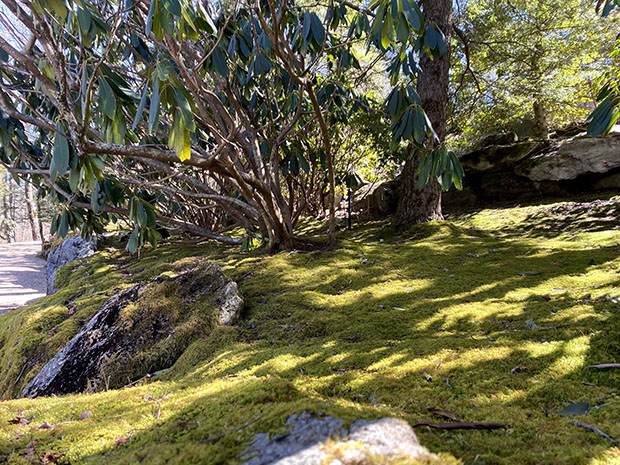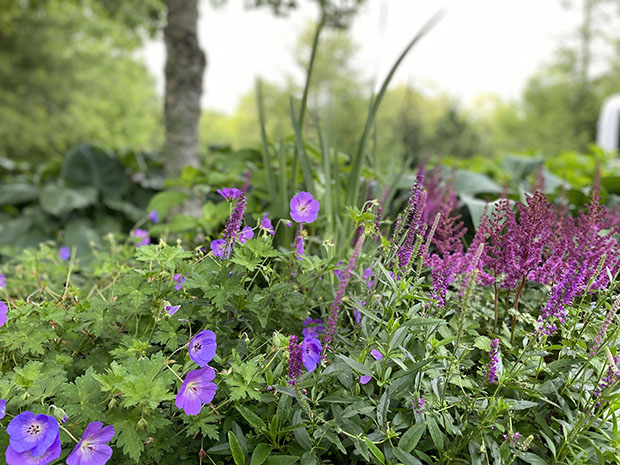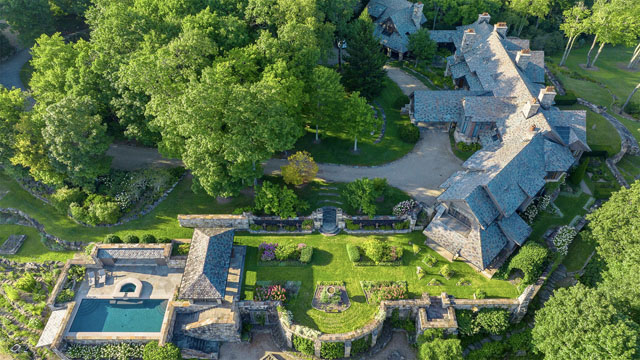Moss is Boss
07 Jun 2022
The benefits of cultivating a beautiful green carpet
Article and photos by Kristin Landfield

“The green mosses, being so many, are as good as brawny.
How important it is to walk along, not in haste but slowly,
looking at everything…To pay attention, this is our endless
and proper work.” -Mary Oliver
Yesterday I walked next to the Shope Fork of the Little Tennessee River in Macon County, North Carolina, where massive boulders tumble along the banks, dripping with moss. A fallen poplar tree crossed the creek. Its colossal body was more green than it was brown, having created a perfect host for moisture-loving mosses. As I looked closely, I saw different mosses weaving together with little sprigs of spores popping up; there appeared to be a miniscule universe within a few square inches of the soft green.
I’ve decided that heaven may actually be fields of green rather than fields of gold—large billowy swaths of moss instead of fluffy clouds. It’s hard to picture anything more transcendent than the electric green of a moss carpet, enhanced only when azure bluets rise sweetly in spring.
Mosses are biomarkers for richness and health in an ecosystem (different from algae in this way, which can be an indicator of imbalance in a watershed).
Generally, mosses can’t thrive under overly exposed conditions. Although there are some species that sustain alpine outcrops and sunnier banks, they do so within a region that already offers abundant resources and rainfall.
Mosses cannot thrive in disturbed areas (just ask someone with puppies who wants a moss lawn). It can’t abide frenzy, so to speak, therefore the presence of moss signals a degree of peace in the terrain. I love the feel of it, to walk barefoot on it—so soothing on a profound level—druidical, ancestral, tranquil. Perhaps what draws us to moss is how it subtly communicates something peaceful to our DNA and downregulates our nervous systems. When I’m in a mossy forest, it hushes something hectic, and I feel glad.
Here in the Nantahala and Pisgah National Forests, moss species are ubiquitous, adorning nearly any surface that remains stationary for long. They are an iconic part of this special landscape.
The granite geology of the area and ambient moisture create amenable conditions for moss to thrive. There are a few hundred moss species identified regionally and many thousands of species globally.
They are Bryophytes that don’t produce flowers, seeds or actual roots. Instead they have rhizoids that cling to surfaces but don’t transport water or nutrients. They are non-vascular, therefore they don’t move resources through their system like most plants and complex organisms. They reproduce by spores that are only viable with moisture.
Although their biology differs from most plants, they serve essential roles in the ecosystem. Mosses and moss-like organisms were the first land plants on earth, were the first to harbor chlorophyll and are the progenitors to the entire plant phylum.
Here are some of the benefits of moss:
-They provide habitat for tiny organisms and are a food source for many invertebrates (Interestingly, reindeer survive harsh climates by eating moss that offers antifreeze properties to their bloodstream).
-Mosses filter groundwater and stabilize terrain from erosion.
-They maintain moisture that supports the growth of other plants. These properties allow them to be forerunners in restoring a landscape after disturbance, as spores can often survive even if the moss does not. Certain spores survived the Chernobyl nuclear disaster and have assisted the reemergence of life after the radioactive devastation.
-They remove CO2 from the atmosphere, and collectively, mosses provide more carbon offset than all the trees on earth. They are being researched for potential in managing climate change.
Moss has also served cultural functions, from historically protecting wounds to artistic and creative endeavors that celebrate its beauty.
In her book, The Magical World of Moss Gardening, Asheville native Annie Martin conveys her love of bryophytes and is an excellent resource for people interested in gardening with moss.
I share her love and believe any natural or developed landscape here on the plateau is enhanced by the beauty of moss. Like so many of our natural treasures, the broad range of local mosses is unique to this temperate rainforest. A high prevalence of springs serves a microbiology in which mosses thrive; in turn, moss catalyzes conditions that foster other plants and animals in the region.
We who enjoy the plateau are witness to a vast and complex ecology embodied in these small plants. When I walk in these mossy Appalachian forests, under their cathedral of trees, all the noise of the day sinks into the oceans of moss. I’m humbled by the moss-covered tumble of boulders reflected in a still pond, by the infinite ecosystem alive in this green magic.














